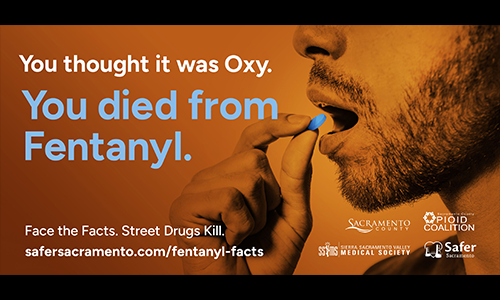
Fentanyl destroys everything in its orbit: individuals, families, communities. It knows no bounds among race, class, gender, or political affiliation. Just 2 milligrams of fentanyl – about the amount that can fit on the tip of a pencil – can kill. Since 2018 over 750 people have died in Sacramento County from fentanyl-related overdoses and poisonings. And the body count keeps rising. Now more than ever, there is an urgent need to communicate the dangers of this deadly drug and educate audiences about how to protect themselves and the ones they love. The goals of the Safer Sacramento Fentanyl Awareness Campaign were simple: educate audiences about the fentanyl crisis in Sacramento County and drive them to the campaign website to learn more, share content, connect with treatment, and find harm reduction tools such as free Narcan. To maximize the reach and effectiveness of the Safer Sacramento Fentanyl Awareness Campaign, we focused on storytelling rooted in the science-based truth about the impact of fentanyl on families and communities.
In addition to educating audiences about the dangers of fentanyl and its prevalence in street drugs, we sought to communicate the ripple effect that the fentanyl crisis is having across Sacramento County: the pain of losing a loved one to fentanyl poisoning or overdose never stops. Creatively, we designed an aesthetically, emotionally, and psychologically striking campaign that would inspire audiences to want to learn more and spread the word.
Taking a fresh approach to content and information delivery is the first step to changing behavior and improving health outcomes. Our campaign strategy was rooted in four research-based educational strategies proven to influence behavioral change. Educational research shows that in order to enhance the public's readiness to learn, accept new information, and change behavior, there are four basic requirements:
By leveraging these strategies, we created and distributed content that impacted how our message was received, perceived, and accepted, moving decision-making in a positive direction.
We took a documentary-style approach to this project, attempting to cover this complex issue from multiple angles and perspectives. However, the centerpiece of this narrative was the kids and families and their stories, which provided nuance and infused meaning into all of the other campaign content.
The success of the Safer Sacramento Fentanyl Awareness Campaign depended on connecting with families, professionals, and community leaders in Sacramento County and allowing them to share their stories on camera. We interviewed parents who lost children, brothers and sisters who lost siblings, community leaders who lost neighbors, politicians pitching solutions, and professionals desperately trying to curb an epidemic that feels out of control.
In addition to video, we integrated branded static content into the social media feeds so that it was impossible to scroll without facts and alarming visuals jumping off the screen: fake pills designed to look like brand-name medications but cut with fentanyl; the minuscule amount of fentanyl that is capable of killing; the life-saving power of Narcan and how to use it.
Alongside our social efforts, we designed a unique set of billboards whose creative qualities lay outside the aesthetic norms for this type of campaign. We used color, contrast, composition, and copy to give the public something they had never seen before. We adapted these billboards and created transit stop posters that were posted around Sacramento County bus stops. We included QR codes so people could scan, click, and learn more about the dangers of fentanyl, what they can do to protect themselves, and how to find treatment.
The Safer Sacramento Fentanyl Awareness Campaign targeted individuals in Sacramento County, ages 18-65+. Campaign results were measured by tracking reach, impressions, engagements, video views, post-link and QR code clicks, engagement rate, and website visits. We reached over 559,800 people during the six-week campaign, with over 412,000 impressions and over 32,000 engagements. Campaign videos garnered over 390,000 video views, and there was an overall engagement rate of 7.8% (1%-3% is considered good). Over 5,600 people clicked through to the website. We increased Safer Sacramento's brand awareness and expanded its social media audience by over 1,200%.
Additionally, this campaign spurred sister campaigns for recovery services and overdose awareness. Our follow-up Overdose Awareness Campaign reached hundreds of thousands of Sacramento County residents and spurred a free Narcan giveaway initiative conducted by the county.
As a boutique creative agency working with a limited budget, we are proud of what we’ve accomplished with the Safer Sacramento Fentanyl Awareness Campaign, and we know that our efforts have saved lives, inspired people to enter treatment, and prepared people to confront the dangers of fentanyl. Read the case study, watch videos, and learn more.









